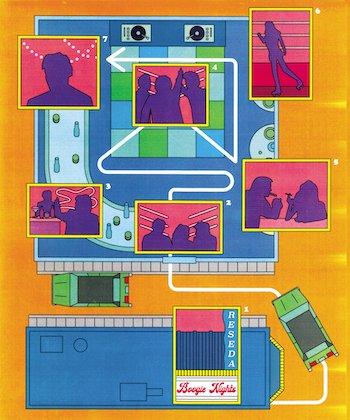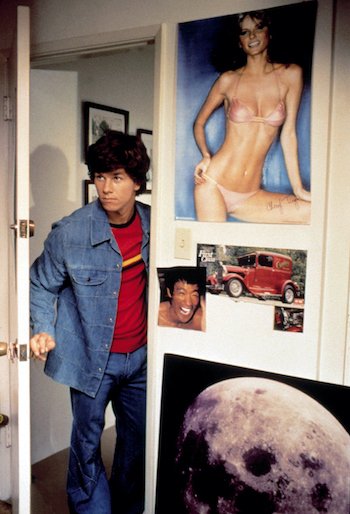
Beneath the nostalgia and fetishism of Boogie Nights’ origins lay thornier impulses. Hard Eight was harshly treated by its distributor — re-cut and re-titled, a symbolic circumcision — and Anderson’s desire to make a follow-up on his own terms was unshakeable. “I wrote [Boogie Nights] fueled by a desire for revenge on all the people who told me I’d never amount to anything,” he told Creative Screenwriting — an observation that connects to the petulance that manifests around the edges of the script. The first instance is Eddie’s defiant tirade against his overbearing mother (Joanna Gleason) after she tells him he’s a loser; in light of Anderson’s comments, it’s hard to not hear the filmmaker’s voice in Eddie’s response.
“You don’t know what I can do!” he bellows at her before packing his bags to leave Torrance for good. “You don’t know what I can do, what I’m gonna do, or what I’m gonna be! I’m good! I have good things that you don’t know about! I’m gonna be something! I am! And don’t fucking tell me I’m not!”
Much later in the film, after Eddie has adopted the decadent Dirk Diggler persona and enjoyed the spoils of his star-is-born narrative, he more or less repeats this outburst, directing his energy instead at Jack, his surrogate father. Well past the need to argue for his own potential, he tries to assert dominance: “You’re not the king of Dirk. I’m the boss of me. I’m the king of me. I’m Dirk Diggler. I’m the star. It’s my big dick and I say when we roll.”
That we are meant to sympathize and identify with Eddie in the first case but not Dirk in the second is in keeping with Boogie Nights’ underlying thesis about the thin line between desire and self-delusion, which figures into the psychology of almost all of its main characters. Eddie yearns for stardom, but once he achieves it, the winning innocence that initially hypnotizes the camera becomes corroded and he’s exposed as a limited talent — an archetypally cruel starlet narrative transposed, provocatively (if not necessarily more than that) onto a male ingenue. Jack sees himself as a principled artist deploying eroticism in the service of storytelling, whose dream is to “make a film that is true and right and dramatic,” yet he more believably displays the traits of an exploiter and an enabler and, at his lowest point, capitulates to the sensationalism his oeuvre means to resist. Amber Waves (Julianne Moore) has styled herself as a sort of den mother for Jack’s repertory — a rock of stability and support — while she struggles with the guilt of being separated from her biological son and the ravages of a cocaine habit (her yonic moniker signals maternal anxiety).

Paul Thomas Anderson: Masterworks by Adam Nayman is out this week.
Buck Swope (Don Cheadle) can’t reconcile the flamboyance of his post — Cleavon Little “Black Cowboy” shtick with his wish to open a stereo equipment store. Hanger-on Scotty (Philip Seymour Hoffman) proffers macho camaraderie to Dirk in an attempt to disguise his deep-seated romantic attraction. “Little” Bill Thompson (William H. Macy), Jack’s long-tenured assistant, leverages an easygoing swinger persona against the rage and paranoia building up every time he catches his wife (Nina Hartley) in flagrante delicto with a stranger (or two).
In a movie of symbolically ejaculatory outbursts, Bill’s decision to commit an act of unfathomable savagery in the midst of a New Year’s Eve party is the most startling, made more unsettling by the implications of its staging.
When Jack apprises Eddie as a “seventeen-year-old piece of gold,” it’s in the aftermath of a virtuoso three-and-a-half minute take that prowls through Hot Traxx, introducing nearly all of the film’s key players and emphasizing their tender, multi-directional affection: They’re all happily caught up in the camera’s swirl. As the Emotions’ throbbing, upbeat disco hit “The Best of My Love” plays in the background, Boogie Nights’ opening conveys, in high style, a moment and a community where everything seems possible and permissible. It’s a continuation — or reboot — of late-sixties Californian utopianism even after the nightmares of Altamont and Manson, events whose counter-cultural implications are absent in the shiny, accessible decadence on display. The idea of a lifestyle without limitations or boundaries is emblematized by Heather Graham’s “Rollergirl,” a porn starlet in Jack’s stable whose gimmick is having sex in her roller skates. In the opening scene, she’s like a cartoonishly obscure object of desire, careening through Hot Traxx with an intrepid, headlong momentum; her serene velocity suggests the thrill of the chase, or maybe the elusiveness of genuine fulfillment in a milieu calibrated in favor of all things fleeting.

Mark Wahlberg is Dirk Diggler in Boogie Nights
The tracking shot during the New Year’s Eve party, meanwhile, reverses that heady sense of optimism, moving instead inexorably towards a set of consequences. Throughout the party sequence, characters are shown bumping up against the painful reality of their own desires, as in the moment where Scotty makes an ill-fated pass at Dirk and ends up crying alone in his new muscle car, helplessly consolidating his position as an outsider to a set of heterosexual revels. The sight gag of Buck, whose girlfriend has dumped him, sitting alone in Nile Rodgers drag similarly places him at the margins of his adoptive family; when he chats up his sometime co-star Jessie (Melora Walters), it’s only because the latter has, like Scotty, been rejected by Dirk, who has in turn just been seduced by Amber into trying cocaine for the first time. By the time the camera attaches itself to Bill as he walks in on his wife cheating on him yet again, stalks outside to his car (a path linking him subtly to Scotty), and returns with a pistol in hand, the film’s trademark sense of momentum has become pressurized, and even weaponized: instead of being carried along on a wave of euphoria, we’re trapped on a downward trajectory.
Also read: Aaron Sorkin Had One Rule For The Trial of the Chicago 7
Bill’s terrible act serves as a jolt at the exact midpoint of the movie, confirming Boogie Nights as a fully bifurcated work. The murder-suicide is staged as the grim herald of shifting decades: in the instant of Bill’s death, Anderson throws up a title card reading, simply, “80s.” The sudden introduction of this particular narrational device eighty minutes into a film that has not previously employed it is intentionally bewildering, recalling the irregular and eccentric use of title cards in The Shining, a horror movie that was set, produced and released in 1980. But the Kubrick joint that comes more readily to mind in the aftermath of Bill’s act is Full Metal Jacket, both in the way Paul Thomas Anderson copies the composition of the suicide itself — including the way blood and brain spatters against the back wall as in an action painting — and uses the imagery of “climax” to reset the narrative. In Full Metal Jacket, Pvt. Pyle (Vincent D’Onofrio) kills Sgt. Hartman (R. Lee Ermey) in ecstatic defiance of the Parris Island barracks’ top-down, authoritarian sense of order before turning the gun on himself in a gesture of punishment and orgasmic release (paying off the Marine Corps’ rhetoric of a rifle as an extension of the soldier who carries it). Bill’s gesture signifies something else. Beyond its parameters as a completely localized act of vengeance and catharsis, it’s like a general rejoinder to the gleeful hedonism of Jack Horner’s little corner of the Valley: a money shot of a different kind.
Excerpt from the new book Paul Thomas Anderson: Masterworks by Adam Nayman, published by Abrams. Available tomorrow. Text © 2020 Adam Nayman and Little White Lies.

